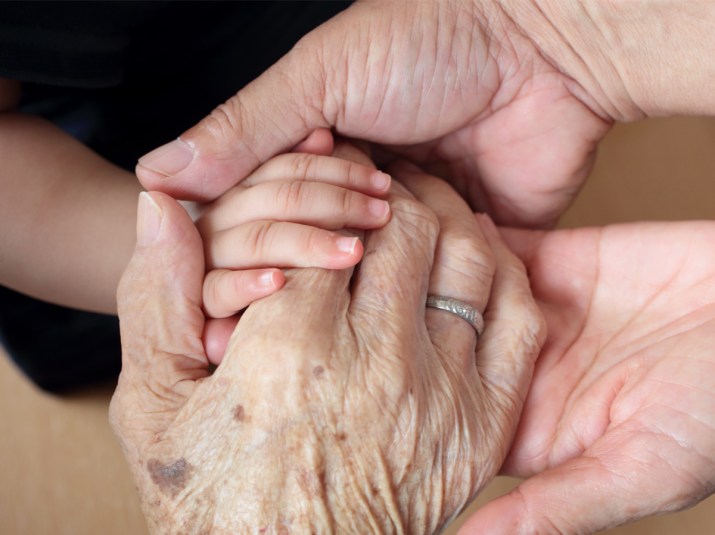How to Care for Kids and Elderly Parents, Simultaneously

Each day, scores of American parents spend hours taking care of their kids’ needs — and some of them are also looking after their own parents. While they are checking homework, preparing school lunches, and driving to and from activities, they may also be picking up prescriptions, helping with taxes or insurance forms, or accompanying Mom or Dad to medical appointments.
About one in eight Americans are simultaneously raising a child and caring for a parent, according to Pew Research Center. What’s more, there are upward of 10 million adults caring for an aging parent remotely. The “Sandwich Generation,” those wedged between senior parents and children under the age of 18, can experience many unique challenges.
“The stress can be high as they juggle care for multiple people along with their jobs, other relationships, home, health, animal care, hobbies, or volunteer work,” says Amy Goyer, AARP’s Caregiving Expert. “They have a great deal on their plates and often feel like they just can’t do it all.”
The good news is, adopting a few smart strategies can help seamlessly navigate these challenges.
Manage Your Money
According to Goyer, family caregivers spend $7,000 per year in out-of-pocket expenses, while long-distance family caregivers spend an average of $12,000. “We all want what’s best for our loved ones, but our efforts often leave us dealing with our own financial challenges,” she says.
Goyer suggests reviewing your finances and coming up with a caregiving budget that allows you to contribute to the needs of your family without threatening your financial security. Look into working with a financial advisor who can help you understand the value of the cash you contribute to caregiving, the debt you may incur, and the long-term effects it may have on your employment situation.
“If your loved ones’ budget along with your contributions aren’t enough, determine how to fill the gaps,” says Goyer. She recommends checking if your parent is eligible for public or veteran benefits, or if there are other services that would lessen your financial burden. Maybe other family members can contribute money or care? Perhaps combining households would lower costs? Be sure to explore your options.
Adjust Your Hours
About 60 percent of family caregivers are also working at a full- or part-time job, says Goyer. Their caregiving work averages about 20 hours a week on top of their time spent in the office.
For those having a hard time juggling it all, Goyer suggests examining your schedule and, if you can, adjusting your hours to start earlier or later in the day. Requesting a predictable schedule or a compressed work week might allow you to better manage the needs of your family. Other options include telecommuting, working at an office location that’s closer to your loved ones, job sharing with another employee, or opting for a phased retirement to gradually cut back your hours.
Be creative. “Ask how you can use paid or unpaid, vacation, sick, personal, caregiving, bereavement, FMLA, donated leave and Family and Medical Leave Act (FMLA) or military caregiver leave,” says Goyer. “But if you are considering leaving a paid job, make the choice fully aware of all of the ramifications.” Family caregivers over age 50 who leave the workforce due to caregiving lose on average more than $300,000 in lifetime wages and benefits.
Take Care of Yourself
Caring for one’s kids can sap the energy out of even the most unflappable individual. Throw in being responsible for the needs of an elderly parent and many caregivers find themselves feeling stretched.
“In my view, all family caregivers are sandwiched between caring for loved ones and all the other parts of their lives,” says Goyer. “Our time is eaten up with everything else and we put self-care at the bottom of the list. It can lead to burnout.”
Goyer says it’s crucial for caregivers to stay organized, defining roles and responsibilities, so efforts aren’t duplicated and balls aren’t dropped. But equally important, is to not forget to schedule “me” time. “Focus on ‘tune ups,’ she says. “Take a week or at least a few days when you aren’t caring for anyone else but yourself. Take a vacation, attend a retreat, go to a favorite, meaningful place.”
She also stresses the importance of “routine maintenance.” This includes getting enough sleep, eating healthily, exercising regularly, getting preventive health check-ups, and counseling or life coaching, where warranted.
Give Yourself a Break
Of course, you can do your best to cover all bases and still feel like your efforts aren’t cutting it. In this case, Goyer says to cut yourself some slack. “All working family caregivers struggle with how to meet loved ones’ needs and still do their best work,” she says. “I had to change my view of success – invariably I couldn’t do everything, but I realized that didn’t mean I was a failure. I realized that success is getting back up when we get knocked down and continuing to do my best alongside my loved ones in the unpredictable journey of caregiving.”
More From FIRST
How to Be a Good Middle-Aged Daughter to an Aging Parent
Let’s Talk About Caregiver Stress — And 6 Ways to Avoid Burnout
How to Be Kind and Compassionate When Talking to Your Aging Parents About Personal Hygiene













